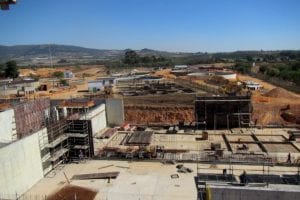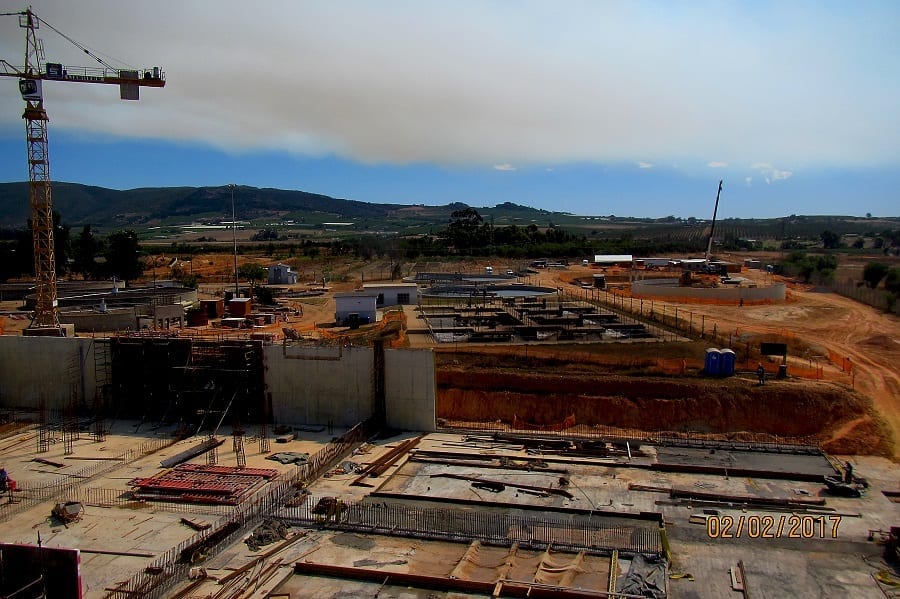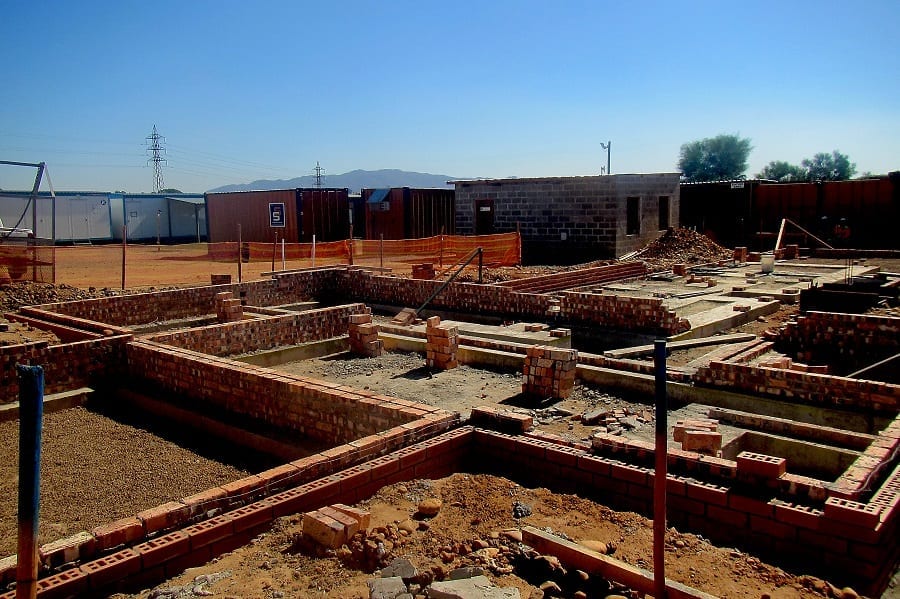To achieve this, a sludge pump station and two 5 km long pipelines will be constructed to convey primary sludge and waste activated sludge from the Wellington WWTW to the new centralised sludge treatment facility. Construction of the pipelines is at 55% and Woodburn hopes to have the bulk of the work completed before the 2017 Cape winter. Although there are no major technical challenges, the coming rains will delay completion, and local community challenges have no doubt hampered progress on
the project.
The R305 million Wellington Wastewater Treatment Works (WWTW) upgrade is a priority project under Drakenstein Municipality’s Integrated Development Plan.
With an existing design capacity of 6 Mℓ/d, the Wellington WWTW has become overloaded from both a hydraulic and organic perspective, rendering the plant unable to treat the incoming wastewater suitably. This has affected the ability of the WWTW to comply with effluent discharge standards, presenting a major risk to downstream users and ecosystems in the Berg River – an important water resource in the region, explains Ronald Brown, senior engineer: Wastewater Services, Drakenstein Municipality.
The incoming wastewater flow is also close to exceeding the design capacity of the existing plant, which will hinder future development in the catchment area – specifically social housing development in Wellington and surrounds. Drakenstein Municipality has a very strong focus on installing bulk services prior to the implementation of any housing projects and other developments, says Brown. In addition, a number of the assets at the current plant have exceeded their life expectancy, further necessitating the upgrade. However, the large capital cost the project meant it was delayed for a year (due to funding constraints) before it was elevated to a high priority and funding was procured from within the municipality and the Municipal Infrastructure Grant.
The project involves an upgrade of the WWTW to a full biological nutrient removal process capable of handling up to 16 Mℓ/day, catering for the seasonal changes in the influent load experienced during the agricultural harvesting season when the organic loading on the plant increases significantly. “The plant’s process operation design caters for this scenario by varying key process parameters during the harvesting season to ensure effluent quality compliance,” explains Neeren Govender, technical director: Wastewater Engineering, Aurecon.
Expansion plans
The existing WWTW comprises an inlet works (screening and grit removal), primary settling tanks (PSTs), biological filters, an activated sludge reactor (Modified Ludzack-Ettinger process configuration), secondary settling tanks (SSTs), chlorine disinfection, and sludge treatment facilities. The sludge treatment process comprises the anaerobic digestion (cold process) of primary sludge, which is then dewatered on sludge drying beds, and the dewatering of waste activated sludge in a sludge lagoon.
The upgrade and expansion comprise the civil, mechanical and electrical works associated with the construction of an inlet works to replace the existing inlet works, two new 12 m diameter PSTs, a 20 000 m3 biological reactor (UCT process configuration), two 33 m diameter SSTs, a closed-vessel UV disinfection facility, various recycle pump stations, a blower room to feed the fine bubble diffused aeration system, and an emergency overflow pond. Further civil works comprise various buildings, including an administration building and new access road, as well as all associated stormwater, potable water, on-site sewerage, a wash-water pump station and network, and landscaping, says Carel Davids, engineer, Neil Lyners and Associates.
According to John Woodburn, director, Stefanutti Stocks Coastal, construction on the PSTs is close to completion, with the inlet works, biological reactor, return flow pump stations, and main sludge pump station all more than 60% complete, and the SSTs approximately 50% complete. Construction on internal access roads and buildings has begun.
Automation controls
The upgrade will allow for the full automation of the WWTW. The entire plant will be monitored, recorded and controlled via a centralised supervisory control and data acquisition (Scada) system. This was considered necessary due to the size and complexity of the upgraded plant, and to optimise the process control and operation efficiency, explains Govender. All of the activities critical for ensuring plant performance – including primary sludge wasting, waste activated sludge wasting, operation of the main sludge pump station and aeration – will be fully automated.
Biological treatment upgrade
Due to its overloaded state, the existing Wellington WWTW is not compliant with the prescribed effluent treatment requirement in terms of Section 39 of the National Water Act (No. 36 of 1998). For this reason, the biological treatment process will be upgraded to ensure complete nitrogen and phosphate removal, and ultimately compliance.
Biological aeration is a vital function in any WWTW to ensure organic and nutrient removal in a conventional activated sludge system, and typically accounts for between 40% and 60% of the annual running cost of a WWTW, primarily due to the high cost of the electrical power required, explains Govender.
The Wellington WWTW will incorporate a fine bubble diffused aeration system, which is more efficient than most other aeration systems, resulting in lower energy requirements. In addition, high-efficiency blowers were specified to supply air to this system, further reducing energy requirements.
The effluent disinfection process will comprise a closed-vessel UV disinfection process. Initial calculations show that this system will have a lower life-cycle costing when compared to the gas chlorination system installed on the current plant. UV technology also has other advantages over chlorination, adds Govender, namely avoiding the safety concerns around handling and storing chlorine as well as being effective against chlorine-resistant pathogens like Cryptosporidium parvum and Giardia.
Centralised sludge treatment
A feasibility analysis was undertaken during the design stage to determine the cost of upgrading the existing sludge treatment facilities at the Wellington WWTW versus conveying the sludge to the Paarl WWTW and creating a centralised sludge treatment facility. The latter was found to offer a cost saving for the municipality because the Paarl WWTW already has more extensive sludge treatment facilities in place, and thus requires less capital investment, explains Brown.
According to Govender, a centralised facility also offers economy-of-scale benefits, opens up opportunities to utilise gas from the anaerobic digestion processes to generate electricity, and is beneficial from an operation and maintenance perspective. The centralised facility will cater for the treatment of sludge generated at the Paarl WWTW, the upgraded Wellington WWTW and the future Paarl South WWTW.












